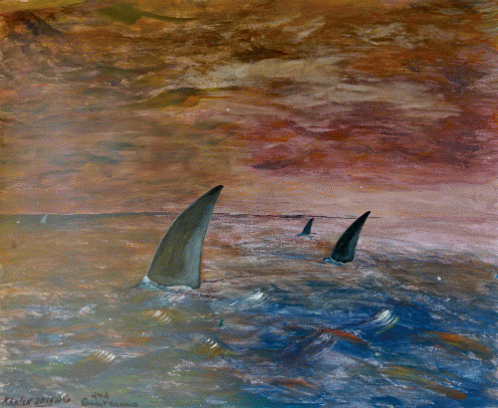Khalid Qasim, Untitled (Fins in the Ocean), 2016.
I was indeed the Other. I might misinterpret and misrepresent, but so undoubtedly would anyone else in our world speaking for those artists. And they were incapable of speaking for themselves.
So I added an essay of my own to the catalog, becoming ekphrastic. I pointed out what was movingly missing in their artwork. It wasn't that there weren't people in their paintings. It was that those works had invisible holes where the people should have been. All those unmanned boats, sailing across those open waters, were carrying invisible self-portraits of the artists as they hardly dared to imagine themselves: free. Even when there were no boats, the famously mutable sea served as the perfect disguise. Its winds and waves and rocks represented the all-too-human emotions of the artists without ever making them visible to the censors.
It was, of course, so much less dangerous for me to interpret what they were saying than for them to say it directly. I had held many doors open for my father when I was his amanuensis, running ahead to make sure the path was clear and that there were no surprising flights of stairs. If there were, it was up to me to find a new way.
This is what I wanted to do for the artists. Open doors, scout out paths -- but their choice of doors, their choice of paths, not mine. They had told me they wanted people to see them as human beings and that was the case I tried to make for them.
As it turned out, I evidently succeeded a little too well. After the exhibit opened and received a surprising amount of media attention, the artists' lawyers noticed that the authorities were taking longer and longer to clear artworks to leave Guanta'namo. Then, three weeks ago, the Department of Defense declared that all art made at Guanta'namo is government property. Detainees reported that their guards then told them any art left behind if they were ever released would be burned and works in their cells deemed "excess" would simply be discarded.
As with so many policy decisions about Guanta'namo, the true rationale for this one remains hidden. My guess: the U.S. authorities there were surprised that the artwork they had been scrutinizing so carefully for hidden messages had a unifying one they had missed: that its makers were human beings. Which is precisely the realization the authorities need to stop the rest of us from having if Guanta'namo is to remain open.
Erin L. Thompson, co-curator of "Ode to the Sea: Art from Guanta'namo" with Charlie Shields and Paige Laino, is an assistant professor of art crime at John Jay College. Her book, Possession: The Curious History of Private Collectors from Antiquity to the Present, was an NPR Best Book of 2016. Follow her on Twitter at @artcrimeprof.
[Note: The exhibit "Ode to the Sea: Art from Guanta'namo" is on display in New York City at the President's Gallery of John Jay College, 899 10th Avenue (6th Floor) until January 28, 2018.]
Follow TomDispatch on Twitter and join us on Facebook. Copyright 2017 Erin L. Thompson
(Note: You can view every article as one long page if you sign up as an Advocate Member, or higher).






